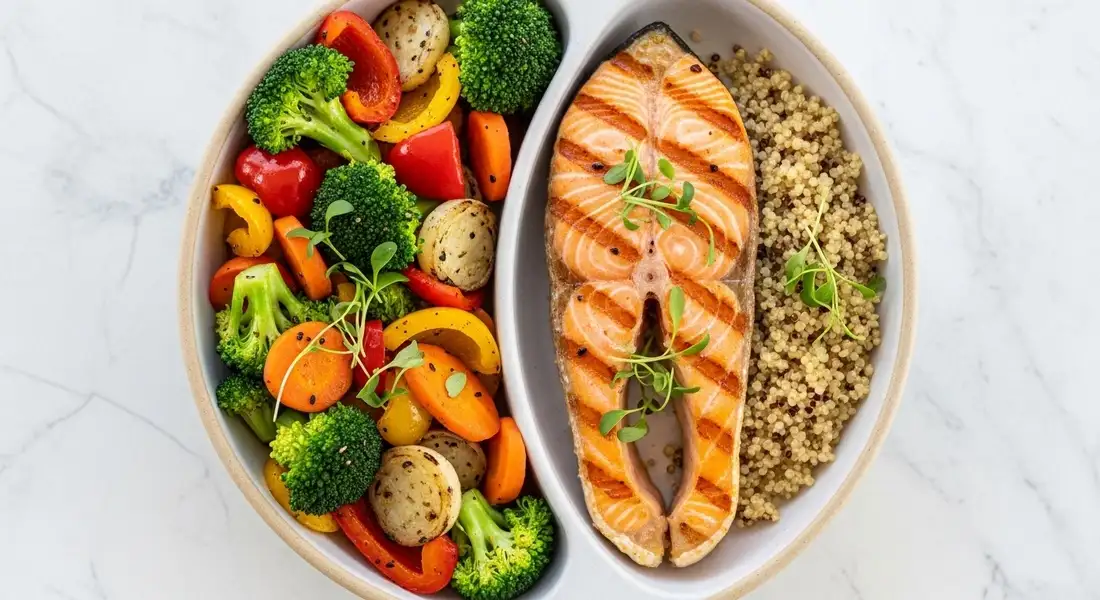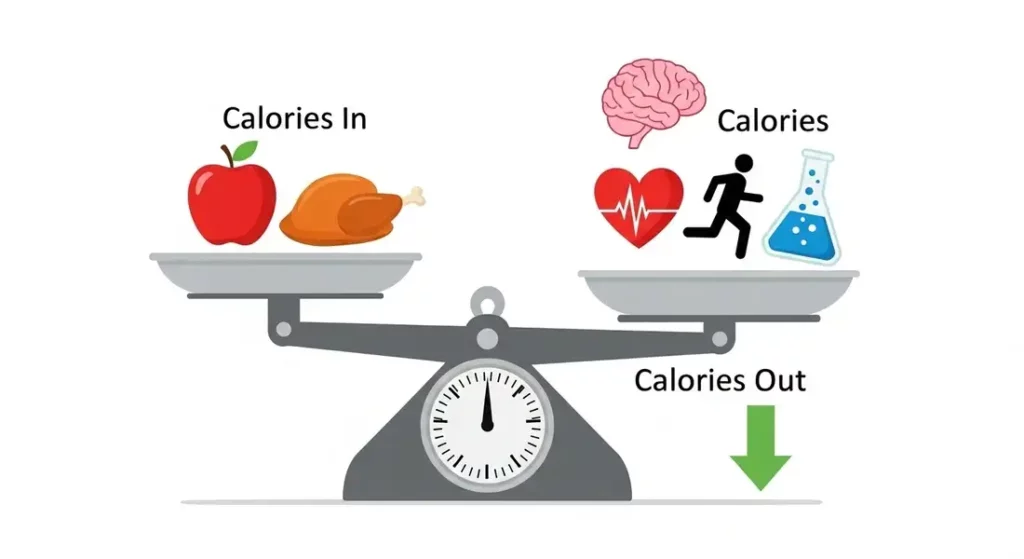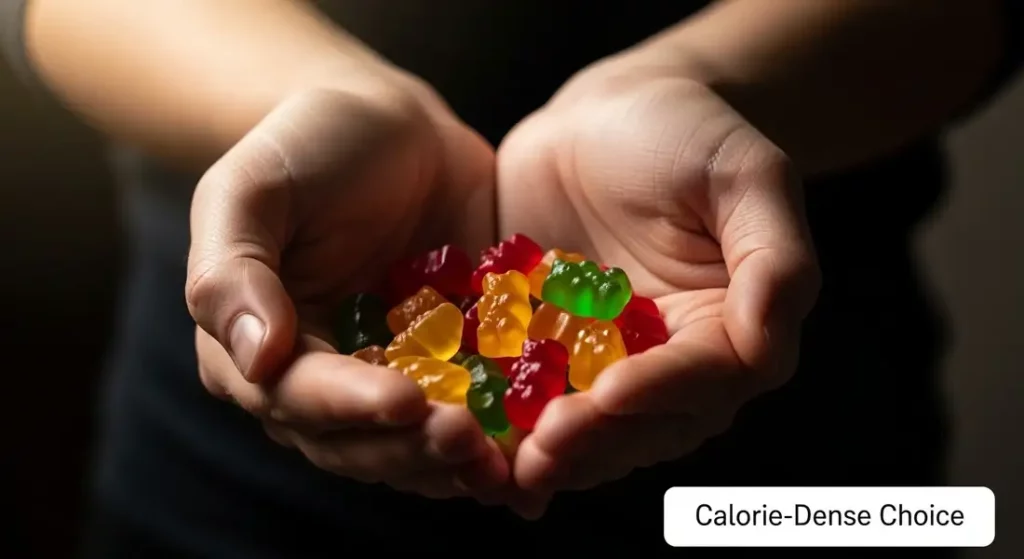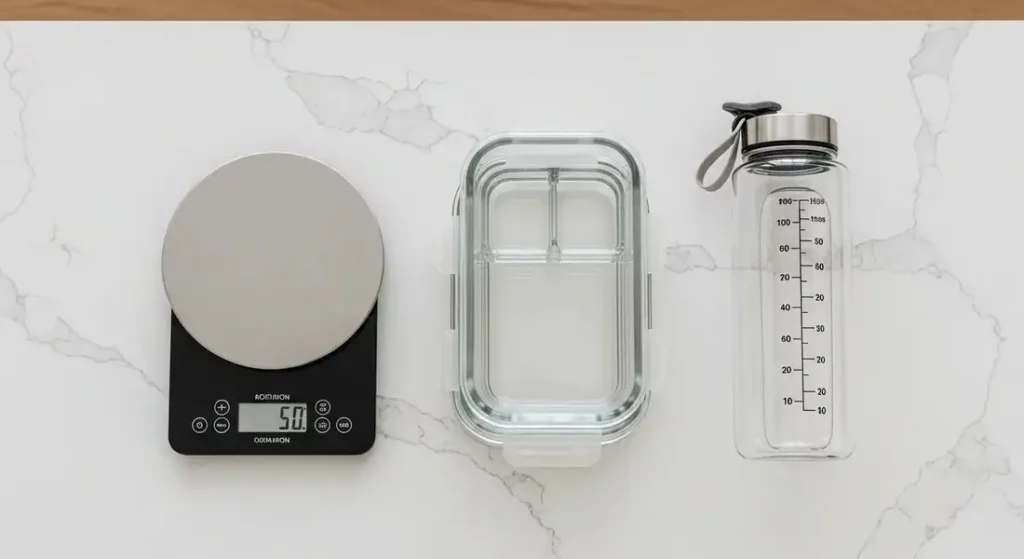So far in our Beginner’s Guide to Weight Loss at Home, we’ve covered exercise.
But no amount of training can consistently produce results without the right fuel.

This brings us to the most critical piece of the puzzle: nutrition.
The term “calorie deficit” is the scientific foundation of weight loss.
It doesn’t mean starvation or deprivation.
As your coach, I’m here to demystify this concept and show you how to create a calorie deficit in a healthy, sustainable way that fuels your body for your workouts and for life.
Disclaimer: Always consult with a healthcare professional or a registered dietitian before making significant changes to your diet.
What Exactly is a Calorie Deficit?

A calorie is a unit of energy. Your body burns calories 24/7 to perform all its functions.
This is your Total Daily Energy Expenditure (TDEE).
A calorie deficit is simply a state where you eat slightly fewer calories than your TDEE.
When this happens, your body turns to its stored energy—your body fat—to make up the difference. It’s the fundamental mechanism of fat loss.
The Golden Rule – Quality Over Quantity
Focusing on nutrient density is the secret to success.
You want to choose foods that provide a high amount of nutrients (vitamins, minerals, fiber) for a relatively low number of calories.
For example, 200 calories of strawberries (high in fiber and volume) will keep you feeling full and satisfied, while 200 calories of gummy bears (pure sugar) will leave you hungry and craving more.
The Nutrient-Dense Choice – A Large Bowl of Strawberries

For 200 calories, you can eat a surprisingly large volume of strawberries.
This choice is packed with fiber, vitamins, and water.
These components work together to make you feel physically full and satisfied for a longer period, curbing the urge to snack later.
The Calorie-Dense Choice – A Small Handful of Gummy Bears

For the exact same 200 calories, you get a small handful of gummy bears.
This choice is almost entirely sugar.
It will give you a quick, temporary spike in energy, but it contains no valuable nutrients and will likely leave you feeling hungry and craving more just a short time later.
By choosing nutrient-dense foods, you can eat satisfying portions and feel full while naturally maintaining a calorie deficit.
The Three Pillars of Your Plate – Macronutrients 101
All calories come from three main “macronutrients”: protein, carbohydrates, and fats.
A balanced intake of all three is essential for a healthy body.
1. Protein – The Builder
Protein is your best friend in a weight loss journey. It is crucial for repairing the muscle you break down during exercise. More importantly, it is the most satiating macronutrient, meaning it keeps you feeling fuller for longer, which helps control cravings.
- Find it in: Lean meats (chicken breast, turkey), fish, eggs, Greek yogurt, beans, lentils, and tofu.
2. Carbohydrates – The Fuel
Carbohydrates have a bad reputation, but they are your body’s primary source of energy. The key is to choose the right kind. Focus on complex carbs, which are high in fiber and release energy slowly. Limit simple carbs, which are digested quickly and can lead to energy crashes.
- Complex Carbs: Oats, brown rice, quinoa, sweet potatoes, and all vegetables.
- Simple Carbs (to limit): Sugary drinks, candy, white bread, and pastries.
3. Fats – The Regulator
Dietary fat does not make you fat. In fact, healthy fats are vital for hormone production, brain function, and absorbing certain vitamins.
They also contribute to feeling full.
- Find it in: Avocados, nuts, seeds, olive oil, and fatty fish like salmon.
Practical Tips for Creating a Sustainable Deficit
You don’t need a complicated spreadsheet to get started.
Just follow these simple, coach-approved principles:
- Prioritize Protein at Every Meal: Aim for a palm-sized portion of a lean protein source with breakfast, lunch, and dinner.
- Fill Half Your Plate with Veggies: Vegetables are the ultimate nutrient-dense food. They are packed with fiber and water, adding volume to your meals with very few calories.
- Be Mindful of Liquid Calories: Sodas, fruit juices, and fancy coffee drinks can contain hundreds of “empty” calories that don’t satisfy your hunger. Stick to water, black coffee, or unsweetened tea.
- Stay Hydrated: Drinking plenty of water is crucial. Sometimes our brains mistake thirst for hunger. The Mayo Clinic provides excellent guidelines on daily water intake.
- Slow Down and Listen to Your Body: It takes about 20 minutes for your brain to register that you’re full. Eat slowly, savor your food, and pay attention to your body’s hunger and fullness cues.
Troubleshooting Your Nutrition – Common Hurdles Solved
Knowing what to do is one thing; doing it consistently is another.
Here’s how to handle the most common challenges.
Problem: “I started eating less, but I feel hungry all the time.”
This is a sign that you’re not focusing on the quality of your food. The solution isn’t to eat more, it’s to eat smarter.
- Prioritize Protein and Fiber: At every meal, ask yourself, “Where is my protein? Where is my fiber (from vegetables)?” These two nutrients are the superstars of satiety, the feeling of fullness. A chicken salad will keep you full for hours longer than a bowl of sugary cereal with the same number of calories.
- Drink More Water: Our brains often mistake thirst for hunger. Before reaching for a snack, drink a large glass of water and wait 15 minutes.
Problem: “I don’t have time to cook healthy meals every day.”
This is the most common practical barrier. The solution is a simple concept called Meal Prep. You don’t have to be a pro chef.
- Cook in Batches: On a Sunday, cook a large batch of a lean protein (like grilled chicken breasts), a complex carb (like brown rice or quinoa), and roast a big pan of vegetables.
- Portion it Out: Divide the cooked food into containers for the next 2-3 days. Now you have a healthy, perfectly portioned lunch ready to grab and go.
Problem: “I’m worried about cravings and social events.”
An all-or-nothing mindset is a recipe for failure. The goal is a sustainable lifestyle, not perfection.
- Embrace the 80/20 Rule: Focus on making healthy, nutrient-dense choices 80% of the time. The other 20% allows for flexibility for things like a piece of birthday cake or a dinner out with friends, completely guilt-free. This approach prevents the cycle of restriction and binging.
Coach’s Toolkit – Tools for Precision and Success

The right tools can take the guesswork out of nutrition and make sticking to your plan almost effortless.
- A Digital Food Scale: This is the single most important tool for understanding what a true portion size looks like. You will be shocked at how small a real serving of cereal or peanut butter is. Using a food scale for just a few weeks is an incredibly educational experience that builds habits for life.
- Glass Meal Prep Containers: Investing in a good set of containers makes meal prepping easy and enjoyable. Glass containers are durable, don’t stain or hold odors, and are safe to microwave. Having your healthy meals packed and ready to go is your secret weapon against weekday temptations.
- A Quality Water Bottle: To hit your hydration goals, you need to make it convenient. A large, reusable water bottle that you can keep on your desk or carry with you serves as a constant visual reminder to drink up. Look for one with measurement markers to easily track your intake.
A Final Word of Caution
Aim for a modest, consistent deficit of 300-500 calories below your TDEE for steady, healthy fat loss.
A severe deficit can slow your metabolism, cause muscle loss, and is simply not sustainable.
Return to the Beginner’s Guide to Weight Loss at Home to see how these nutrition principles support your workout plan.
What is one small change you can make to your plate this week based on what you’ve learned? Share it in the comments!
